
The Australian garden orb weaver spider is a very common species of spider with many variants in size, shape, and colour across the coastal regions of Australia. They have very large abdomens when well-fed and exhibit a tremendous colour-range from off-white through tan, brown to almost black. They have a roughly leaf-shaped pattern on the top of their abdomen with a complex outline that is darker than the surrounding area. There may also be several whitish spots or one or more stripes. The spiders' cephalothoraxes (heads) and proximal leg segments are usually darker, mostly reddish or reddish brown. They are able to change their colour with each moult to better match the background upon which they rest during the day.
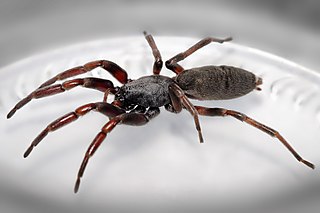
White-tailed spiders are spiders native to southern and eastern Australia, and so named because of the whitish tips at the end of their abdomens. The body size is up to 18 mm, with a leg-span of 28 mm. Common species are Lampona cylindrata and Lampona murina. Both these species have been introduced to New Zealand.

Phidippus audax is a common jumping spider of North America. It is commonly referred to as the daring jumping spider, or bold jumping spider. The spider belongs to the genus Phidippus, a group of jumping spiders easily identified both by their relatively large size and their iridescent chelicerae.
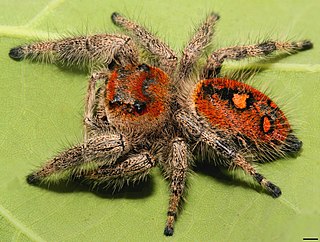
Phidippus regius, known commonly as the regal jumping spider, is a species of jumping spider in eastern North America.

The spider genus Cabello consists of only one species, Cabello eugeni, found in Venezuela. It is a small yellow-white spider, with females 2 mm long, and males 1.6 mm. The eye region is reddish with a dusky median longitudinal band, the sternum whitish, with grey sides. The yellow-white legs have scattered black spots on the anterior face. On the abdomen there are scattered white spots.

Phidippus californicus is a species of jumping spider. It is found in the southwestern United States and northern Mexico.
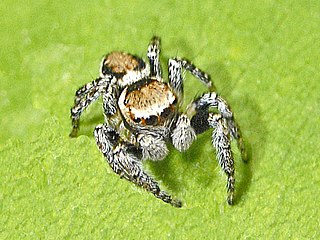
Evarcha falcata is a species of 'jumping spiders' belonging to the family Salticidae.

Gasteracantha cancriformis is a species of orb-weaver spider. It is widely distributed in the New World.

Evarcha arcuata is a species of jumping spiders with a palearctic distribution.
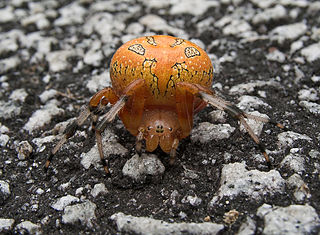
Araneus marmoreus, commonly called the marbled orb-weaver, is a species of spider belonging to the family Araneidae. It is sometimes also called the pumpkin spider from the resemblance of the female's inflated abdomen to an orange pumpkin. It has a Holarctic distribution.

Zygoballus sexpunctatus is a species of jumping spider which occurs in the southeastern United States where it can be found in a variety of grassy habitats. Adult spiders measure between 3 and 4.5 mm in length. The cephalothorax and abdomen are bronze to black in color, with reddish brown or yellowish legs. The male has distinctive enlarged chelicerae and front femora. Like many jumping spiders, Z. sexpunctatus males exhibit ritualized courtship and agonistic behavior.

Plexippus paykulli is a jumping spider in the family Salticidae. It is native to south east Asia but has spread to other parts of the world. In the United States it is called the pantropical jumping spider. It is usually associated with buildings and may be found near light sources catching insects attracted by the light. It is named in honor of Gustaf von Paykull.
Sibirocosa is a genus of wolf spiders containing seven species, all from Russia, mostly found from northeastern Siberia south to Primorsky Krai. Spiders of this genus are dark coloured and hairy with a body length of 5.25 - 7.25 mm.
Sibirocosa kolymensis is a species of wolf spider found in the Kolyma region in the far east of Russia.
Sibirocosa sibirica is a species of wolf spider. It has a fairly wide distribution in Siberia: from the Putorana Plateau east to the Chersky Range and south to northern Transbaikal.
Sibirocosa subsolana is a species of wolf spider. This is a spider of the extreme north-east of Asia, only found east of the Kolyma River to the edge of the Chukchi Peninsula. It is also found on Wrangel Island and may also occur on the Seward Peninsula at the western extremity of Alaska.
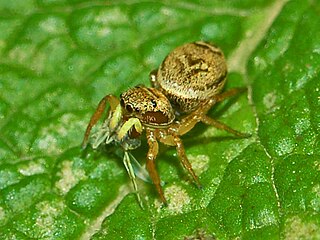
Heliophanus tribulosus is a species of 'jumping spiders' belonging to the family Salticidae.

Cyrtophora parangexanthematica is a species of tent spider found in the Philippines. Its scientific name comes from its close resemblance to double-tailed tent spiders. It was described from a single female specimen collected in 1995.

Episyron quinquenotatus, the white-trimmed black wasp, is a North American species of pompilid spider hunting wasp.
Melecosa is a genus of spiders in the family Lycosidae. Its lone species is found in Kazakhstan, Kyrgyzstan, and China.














